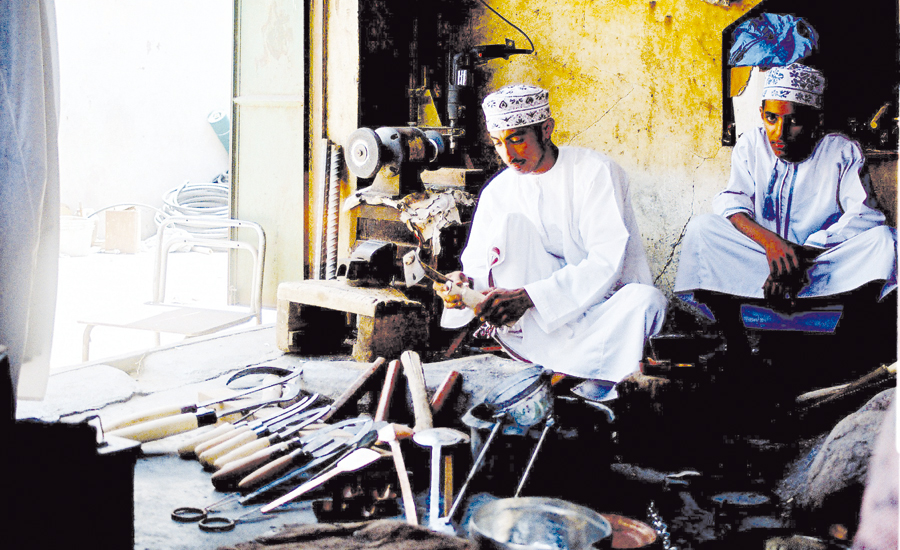

Saleh Al Shaibany -
Despite fierce competition from machine-made imports, the ancient business of traditional weaving, pottery and metal work is still thriving in the inner towns of the Sultanate.
In Nizwa in the Dakhiliya region, Ahmed Al Nabhani, was mesmerising tourists as his fingers moved delicately to form curves of a rim of a large pot, called Jahlah in Arabic. Tourists also watched him kick his potter’s wheel while his hands created a shape from the damp clay. Behind him, his assistant was firing a round-shaped kiln after placing a stack of pots inside the three-metre-deep oven.
His century old workshop, which he inherited from his father and originally built by his grandfather, is not powered by electricity but and the oven is fueled by wood, palm fronds and sometimes coal.
He said that his pots are still made from traditional methods and the use of organic mix dominates the products.
“Traditional pottery does not use electricity or any tool of modern technology,” Al Nabhani explained, “and we use no chemical. Everything we use is natural, unlike the imported products that release harmful chemicals that dissolve with the food or water when it comes in contract with the heat.”
Displayed on the shelves in his workshop, are the pots made by his grandfather a hundred years ago as a proof that nothing has changed in the last hundred years. There were arrays of cooking pots, water storage, kitchen utensils and decorative items, all intricately made from clay and water.
Half a kilometre down the road, Saif Al Shaibany, a silversmith was welding together sheets of silver threads.
He was sitting on a mat woven from palm fronds that he bought from a local family.
His silver threads were neatly folded inside a basket also made locally. He was sitting on the floor of his workshop, surrounded by a collection of hammers of all sizes and shapes.
He was working on an ancient version of a lathe machine. He makes silver coffee pots, jewellery, incense burners and daggers.
Most of his customers are wealthy GCC families because all his products are made from pure silver and in traditional Omani designs.
He also commands princely prices. For example, smaller items of jewellery cost from 100 rials while the larger fetch up to 1,000 rials.
“Chinese made silver jewellery cannot match what we make here. Everything is handmade and our designs bear the mark of the proud Omani tradition,” Al Shaibany explained.
Weaving also thrive in Oman. This trade is mostly dominated by women. They use spinners, hand-operated spindles and ground looms.
Weavers sit out in the open under the shade of a large tent chatting noisily as they work. From large rolls of threads in different colours, made from sheep wool, women of all ages weave linen, rugs, table covers, wall hangings and saddle bags.
They charge from 50 to 125 rials, depending on the items on demand. Like the silverware, most of their market is from the GCC and 70 percent of their products are exported in the region.
But the real challenge of the future of the handicraft trade depends on the new generation whether the children would continue the family businesses or not.
“So far, Omani craft still has a place in the Sultanate’s business circles and it is still in great demand. However, its future survival largely depends on the new generation. There is money to be made in this industry but it involves hard work,” Al Shaibany explained.
James Cahill, a British tourist visiting Oman, acknowledged Omani craft.
“The local tradition stuff they produce here is unique. I travelled to all regional countries but what they produce here is different in designs and beauty. I am a great fan of Omani craft, especially the weaving products and silverware,” Cahill said.
Oman Observer is now on the WhatsApp channel. Click here



